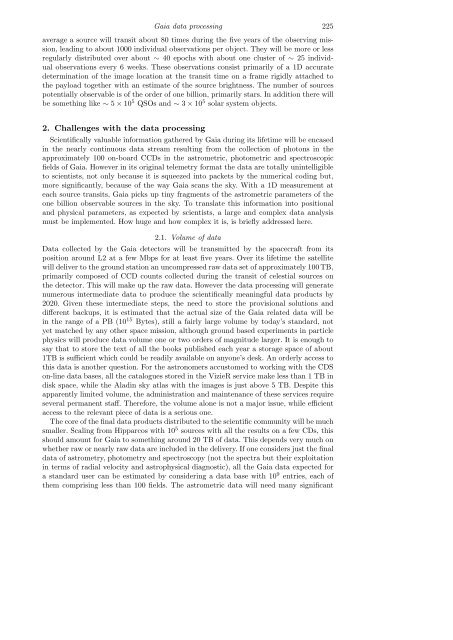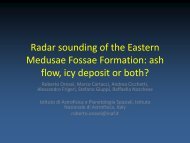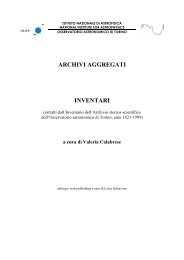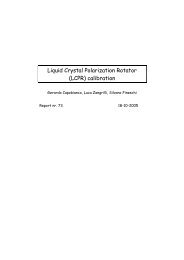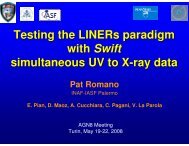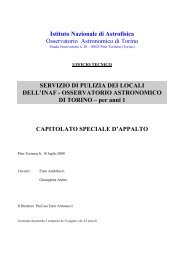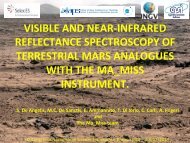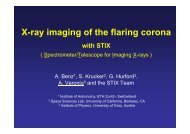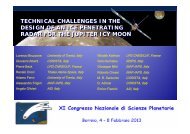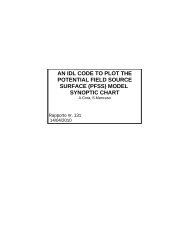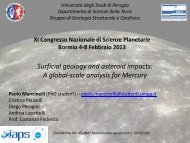Gaia - Osservatorio Astronomico di Torino
Gaia - Osservatorio Astronomico di Torino
Gaia - Osservatorio Astronomico di Torino
Create successful ePaper yourself
Turn your PDF publications into a flip-book with our unique Google optimized e-Paper software.
<strong>Gaia</strong> data processing 225<br />
average a source will transit about 80 times during the five years of the observing mission,<br />
lea<strong>di</strong>ng to about 1000 in<strong>di</strong>vidual observations per object. They will be more or less<br />
regularly <strong>di</strong>stributed over about ∼ 40 epochs with about one cluster of ∼ 25 in<strong>di</strong>vidual<br />
observations every 6 weeks. These observations consist primarily of a 1D accurate<br />
determination of the image location at the transit time on a frame rigidly attached to<br />
the payload together with an estimate of the source brightness. The number of sources<br />
potentially observable is of the order of one billion, primarily stars. In ad<strong>di</strong>tion there will<br />
be something like ∼ 5 × 10 5 QSOs and ∼ 3 × 10 5 solar system objects.<br />
2. Challenges with the data processing<br />
Scientifically valuable information gathered by <strong>Gaia</strong> during its lifetime will be encased<br />
in the nearly continuous data stream resulting from the collection of photons in the<br />
approximately 100 on-board CCDs in the astrometric, photometric and spectroscopic<br />
fields of <strong>Gaia</strong>. However in its original telemetry format the data are totally unintelligible<br />
to scientists, not only because it is squeezed into packets by the numerical co<strong>di</strong>ng but,<br />
more significantly, because of the way <strong>Gaia</strong> scans the sky. With a 1D measurement at<br />
each source transits, <strong>Gaia</strong> picks up tiny fragments of the astrometric parameters of the<br />
one billion observable sources in the sky. To translate this information into positional<br />
and physical parameters, as expected by scientists, a large and complex data analysis<br />
must be implemented. How huge and how complex it is, is briefly addressed here.<br />
2.1. Volume of data<br />
Data collected by the <strong>Gaia</strong> detectors will be transmitted by the spacecraft from its<br />
position around L2 at a few Mbps for at least five years. Over its lifetime the satellite<br />
will deliver to the ground station an uncompressed raw data set of approximately 100 TB,<br />
primarily composed of CCD counts collected during the transit of celestial sources on<br />
the detector. This will make up the raw data. However the data processing will generate<br />
numerous interme<strong>di</strong>ate data to produce the scientifically meaningful data products by<br />
2020. Given these interme<strong>di</strong>ate steps, the need to store the provisional solutions and<br />
<strong>di</strong>fferent backups, it is estimated that the actual size of the <strong>Gaia</strong> related data will be<br />
in the range of a PB (10 15 Bytes), still a fairly large volume by today’s standard, not<br />
yet matched by any other space mission, although ground based experiments in particle<br />
physics will produce data volume one or two orders of magnitude larger. It is enough to<br />
say that to store the text of all the books published each year a storage space of about<br />
1TB is sufficient which could be rea<strong>di</strong>ly available on anyone’s desk. An orderly access to<br />
this data is another question. For the astronomers accustomed to working with the CDS<br />
on-line data bases, all the catalogues stored in the VizieR service make less than 1 TB in<br />
<strong>di</strong>sk space, while the Ala<strong>di</strong>n sky atlas with the images is just above 5 TB. Despite this<br />
apparently limited volume, the administration and maintenance of these services require<br />
several permanent staff. Therefore, the volume alone is not a major issue, while efficient<br />
access to the relevant piece of data is a serious one.<br />
The core of the final data products <strong>di</strong>stributed to the scientific community will be much<br />
smaller. Scaling from Hipparcos with 10 5 sources with all the results on a few CDs, this<br />
should amount for <strong>Gaia</strong> to something around 20 TB of data. This depends very much on<br />
whether raw or nearly raw data are included in the delivery. If one considers just the final<br />
data of astrometry, photometry and spectroscopy (not the spectra but their exploitation<br />
in terms of ra<strong>di</strong>al velocity and astrophysical <strong>di</strong>agnostic), all the <strong>Gaia</strong> data expected for<br />
a standard user can be estimated by considering a data base with 10 9 entries, each of<br />
them comprising less than 100 fields. The astrometric data will need many significant


